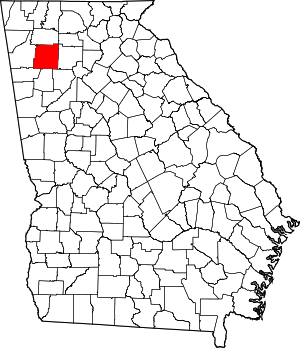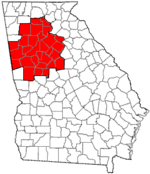Bartow County, Georgia
Bartow County | |
|---|---|
 The Bartow County Courthouse built in 1902 | |
 Location within the U.S. state of Georgia | |
 Georgia's location within the U.S. | |
| Coordinates: 34°14′N 84°50′W / 34.24°N 84.84°W | |
| Country | |
| State | |
| Founded | December 3, 1832 |
| Seat | Cartersville |
| Largest city | Cartersville |
| Area | |
| • Total | 470.11 sq mi (1,217.6 km2) |
| • Land | 459.43 sq mi (1,189.9 km2) |
| • Water | 10.69 sq mi (27.7 km2) 2.27% |
| Population | |
| • Estimate (2011) | 100,421 |
| • Density | 204.7/sq mi (79.0/km2) |
| Time zone | UTC−5 (Eastern) |
| • Summer (DST) | UTC−4 (EDT) |
| Website | www |
Bartow County is a county located in the U.S. state of Georgia. As of the 2010 census, the population was 100,157.[1] A 31.8% increase in less than ten years. The county seat is Cartersville.Template:GR
Bartow County is included in the Atlanta-Sandy Springs-Marietta Metropolitan Statistical Area. It has a sole commissioner government, and is the largest county with a sole commissioner.
History
Bartow County was created from the Cherokee lands of the Cherokee County territory on December 3, 1832, and named Cass County, after General Lewis Cass (1782–1866) Secretary of War under President Jackson, Minister to France and Secretary of State under President Buchannan,[2] until renamed on December 6, 1861 in honor of Francis S. Bartow. The original county seat was at Cassville, but after the burning of the county courthouse and the Sherman Occupation the seat moved to Cartersville, where it now remains.
The county was profoundly affected by the Civil War, setting it back economically for many decades. May 18 and 19, 1864, General Thomas led the Army of the Cumberland after General Hardee's Corps of the Army of Tennessee, and General McPherson led his Federal Army of the Tennessee flanking Hardee's army to the west. This huge army was disruptive and sought food. Elements were out of control and sacked homes depleting meager supplies.[3]
Property destruction and the deaths of one-third of the county's soldiers during the war caused financial and social calamity for many.
Slaves gained their freedom, and briefly exercised political franchise through the Republican Party. In 1870, about 1 black family in 12 owned real estate. Over a third of the blacks lived in white-headed households, working as domestic servants and laborers. The great majority of freedpeople were day laborers or farm laborers, while a sizable minority occupied skilled positions such as blacksmiths, wheelwrights, and iron workers.[4]
By the late 1870s, hardship was experienced by everyone. Blacks had been relegated to second-class citizenship by Jim Crow laws.
Elections
Bartow County has voted Republican since the 1960s.[citation needed] Mitt Romney carried the county in the 2012 presidential election with 75.1% of the vote. Barack Obama won the minority of votes in the county, at 23.5%, making Bartow County one of the least Democratic counties in Georgia.[citation needed]
Geography
According to the 2000 census, the county has a total area of 470.11 square miles (1,217.6 km2), of which 459.43 square miles (1,189.9 km2) (or 97.73%) is land and 10.69 square miles (27.7 km2) (or 2.27%) is water.[5]
Cities and towns
Unincorporated communities
Adjacent counties
- Gordon County, Georgia – north
- Pickens County, Georgia – northeast
- Cherokee County, Georgia – east
- Cobb County, Georgia – southeast
- Paulding County, Georgia – south
- Polk County, Georgia – southwest
- Floyd County, Georgia – west
Demographics
| Census | Pop. | Note | %± |
|---|---|---|---|
| 1840 | 9,390 | — | |
| 1850 | 13,300 | 41.6% | |
| 1860 | 15,724 | 18.2% | |
| 1870 | 16,566 | 5.4% | |
| 1880 | 18,690 | 12.8% | |
| 1890 | 20,616 | 10.3% | |
| 1900 | 20,823 | 1.0% | |
| 1910 | 25,388 | 21.9% | |
| 1920 | 24,527 | −3.4% | |
| 1930 | 25,364 | 3.4% | |
| 1940 | 25,283 | −0.3% | |
| 1950 | 27,370 | 8.3% | |
| 1960 | 28,267 | 3.3% | |
| 1970 | 32,663 | 15.6% | |
| 1980 | 40,760 | 24.8% | |
| 1990 | 55,911 | 37.2% | |
| 2000 | 76,019 | 36.0% | |
| 2010 | 100,157 | 31.8% | |
| 2012 (est.) | 100,661 | 0.5% | |
2012 Estimate[7] | |||
As of 2000, there are 76,019 people, 27,176 households, and 21,034 families residing in the county. The population density is 64/km2 (166/mi2). There are 28,751 housing units at an average density of 24 persons/km2 (63 persons/mi2). The racial makeup of the county is 87.79% White, 8.68% African American, 0.28% Native American, 0.51% Asian, 0.03% Pacific Islander, 1.62% from other races, and 1.10% from two or more races. 3.32% of the population are Hispanic or Latino of any race.
There are 27,176 households out of which 38.20% have children under the age of 18 living with them, 61.90% are married couples living together, 11.10% have a woman whose husband does not live with her, and 22.60% are non-families. 18.70% of all households are made up of individuals and 6.70% have someone living alone who is 65 years of age or older. The average household size is 2.76 and the average family size is 3.14.
In the county the population is spread out with 27.90% under the age of 18, 8.30% from 18 to 24, 33.00% from 25 to 44, 21.40% from 45 to 64, and 9.40% who are 65 years of age or older. The median age is 34 years. For every 100 females there are 97.70 males. For every 100 females age 18 and over, there are 94.90 males.
The median income for a household in the county is $43,660, and the median income for a family is $49,198. Males have a median income of $35,136 versus $24,906 for females. The per capita income for the county is $18,989. 8.60% of the population and 6.60% of families are below the poverty line. Out of the total people living in poverty, 9.60% are under the age of 18 and 12.20% are 65 or older.
Education
Excel Christian Academy (Kindergarten - 12th Grade, SACS Accredited Academy)
The Trinity School (Kindergarten - 8th Grade, SACS Accredited School)
Infrastructure
Major highways
Interstate highways
U.S. highways
State routes
 State Route 3
State Route 3 State Route 20
State Route 20 State Route 20 Spur
State Route 20 Spur State Route 61
State Route 61 State Route 113
State Route 113 State Route 140
State Route 140 State Route 293
State Route 293 State Route 293 Connector
State Route 293 Connector State Route 401 (unsigned designation for I-75)
State Route 401 (unsigned designation for I-75)
Secondary Highways
This section needs additional citations for verification. (August 2013) |
- Euharlee Road
- Old S.R. 293. Portion south of Emerson and east of U.S. 41 into Cobb County.
- Old Alabama Road. Future route of S.R. 113.
- Burnt Hickory Road
- Taylorsville-Macedonia Road
- Macedonia Road
- Halls Station Road
- Spring Place Road
- Cassville-White Road
- Mission Road
Museums
- Bartow History Museum[8] opened in 1987 and is presently located in the historic 1869 Courthouse in downtwon Cartersville, GA. Artifacts, photographs, documents and a variety of permanent exhibits focus on the settlement and development of Bartow County, Georgia, beginning with the early nineteenth century when the Cherokee inhabited the area. Early European settler life, the iron ore and bauxite industries, Civil War strife, Post war recovery, the Great Depression era, early textile industries and notable figures are depicted through interactive exhibits in the permanent gallery space. Additionally, the Museum offers a wide variety of education programs, lectures and membership opportunities.
- Booth Western Art Museum,[9] an Affiliate of the Smithsonian Institution, is a 120,000-square-foot (11,000 m2) museum located in Cartersville, Georgia. Guests are invited to See America’s Story through contemporary Western artwork, Presidential portraits and letters, Civil War art, more than 200 Native American artifacts, and Sagebrush Ranch children’s gallery. Open since August 2003, Booth Museum is the second largest art museum in the state of Georgia, and houses the largest permanent exhibition space for Western art in the country.
- Tellus Science Museum,[10] an Affiliate of the Smithsonian Institution, is a world-class 120,000-square-foot (11,000 m2) museum is located in Cartersville, GA just off I-75 at exit 293. The museum features four main galleries: The Weinman Mineral Gallery, The Fossil Gallery, Science in Motion and The Collins Family My Big Backyard. There is also a 120-seat digital planetarium and an observatory with a state-of-the-art 20-inch telescope located at Tellus.
- Euharlee History Museum, [11] is located adjacent to the Euharlee Covered Bridge in Euharlee, Georgia, about 9 miles west of downtown Cartersville, Georgia. The museum opened in 1997 and is a cooperation between the Euharlee Historical Society and the City of Euharlee.
- Adairsville Rail Depot Age of Steam Museum,[12] is located in a restored 1847 railroad depot on the Historic Public Square, in Adairsville, Ga. along with a locally operated Welcome Center. The Museum displays artifacts and pictures covering almost 150 years of life in the area, including the Civil War, the chenille boom, railroad history, early farming implements, and weapons.
Recreation
- Bartow County Georgia Hiking Trails[13]
See also
References
- ^ United States Census Bureau. "2010 Census Data". United States Census Bureau. Retrieved 8 February 2012.
- ^ [1],
- ^ Howard, Frances Thomas (2007). In and Out of the Lines. Cartesville, Georgia: Etowah Valley Historical Society. pp. 9, overleaf.
{{cite book}}: Cite has empty unknown parameter:|coauthors=(help) - ^ Keith S. Hébert, "The Bitter Trial of Defeat and Emancipation: Reconstruction in Bartow County, Georgia, 1865–1872," Georgia Historical Quarterly, Spring 2008, Vol. 92 Issue 1, pp 65–92
- ^ "Census 2000 U.S. Gazetteer Files: Counties". United States Census. Retrieved 2011-02-13.
- ^ "U.S. Decennial Census". Census.gov. Retrieved July 20, 2013.
- ^ "Annual Estimates of the Resident Population: April 1, 2010 to July 1, 2012". Census.gov. Retrieved July 20, 2013.
- ^ Bartow History Museum
- ^ Booth Western Art Museum
- ^ Tellus Science Museum
- ^ Euharlee History Museum Facebook page
- ^ Adairsville Rail Depot Museum
- ^ Bartow County Georgia Hiking Trails
External links
- AnteBartow County Official Website
- Antebellum Iron Industry in North Georgia Centered in Bartow County


